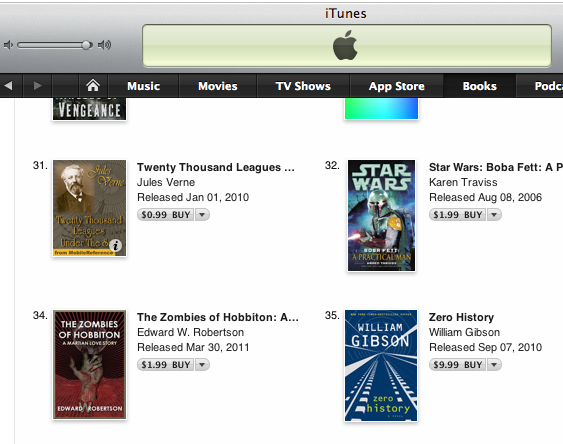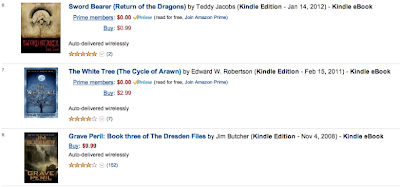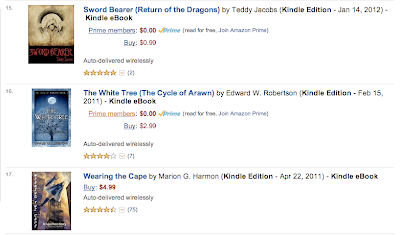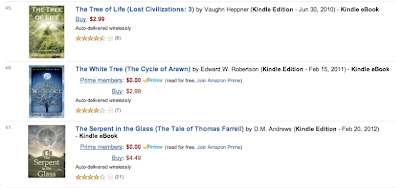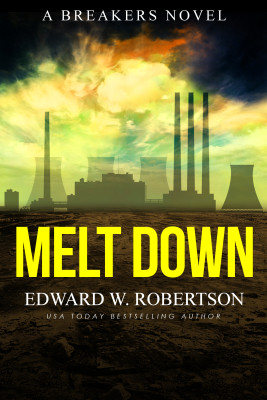Yesterday, I noticed my novella The Zombies of Hobbiton was #34 on iTunes in Science Fiction & Literature. #34! That sounded like big news. Especially considering my Amazon sales are way, way down after the most recent algorithm changes that are strangling Select in its crib. That prompted me to take a real look at the iTunes store for the first time. I love Amazon and all, but I don’t like the idea of having all my eggs in one basket.
Here’s the problem. iTunes is a lot harder to read than Amazon.
There are a whole lot of different factors for this. Some of them are personal. I just haven’t ever really spent any time browsing the store. I’ve looked at my own books a couple times, but I found the store clumsy and confusing, especially when it came to navigation. Guess who just discovered iTunes has a back button!
The second factor is a cultural one. Among indie authors, Amazon is king. It currently owns something like 60% of the ebook market, yet it probably commands closer to 90% of the discussion. People just don’t talk about B&N or iTunes or Kobo or Sony, except perhaps to point and laugh. Maybe I need to expand my horizons, but in the circles I run in, very little analysis is focused on the workings of the other stores. And this makes sense. Who cares about how Kobo works if it’s only pulling 3% of all book sales? (Note: I made that number up.) Just distribute there through Smashwords and forget about it. Now let’s talk about Amazon some more.
In that environment, you don’t get communities of authors coming together to swap information and compare notes. Like, I am aware some indie authors do really well on iTunes or B&N, but I have no clue what’s driving that success.
The third and possibly biggest factor in the unknowns of iTunes is the real killer: I don’t have access to real-time sales figures.
I distribute to iTunes through Smashwords. Smashwords is a great program, but it places a filter between me and what’s happening with my books. For instance, right now, May 13, SW only has updated figures for Apple through March 31. Sales are all tallied on a lump sum, too–like, if SW updates their iTunes on May 15, and I sold 10 books during that period (I didn’t), it will list all those sales as occurring on May 15. Oh, and if you’re giving away a book for free, iTunes doesn’t give out numbers for how many copies you’ve had downloaded.
To summarize: so I’m stumbling around the store, with no real awareness of what I’m looking at, and with sales figures that lag 6-10 weeks behind whatever I might be doing with my books today.
To summarize another way: damn it.
But we can watch the storefront itself. And here’s what I’ve seen so far. iTunes updates constantly–like, possibly more than once an hour. Yesterday, after I spotted my book at #34 on Science Fiction & Literature, it quickly dropped to #35, then #36. A few hours later, it was at #58; a half hour later, it rose to #56, before falling back to #58, #63, and #64 when I stopped paying attention.
This morning, I first saw it back up at #34 (and sandwiched between Iain M. Banks and Neal Stephenson, my two favorite SF authors!). That was about an hour ago. Checking again, it’s currently at #36. I also saw Hugh Howey’s Wool take a big leap yesterday–it vaulted from somewhere in the 60s to #5, propelled, no doubt, by news of Howey’s movie deal. The Wool Omnibus was already at #1. Right now, Wool has slipped to #18, with the Omnibus at #4.
So we’re seeing a lot of volatility. At least within this category. What this suggests to me is that the sample size of sales is pretty low. It may only take a handful to vault you to the top, and if you don’t continue to sell regularly, you’ll quickly be knocked off the list by those who are. Possibly, it took me just one sale to get The Zombies of Hobbiton to #34. After that, it slid throughout the day into the #60s until this morning, when it sold another copy, kicking it back up to that same #34 placement. That small rise yesterday afternoon from #58 to #56 suggests the possibility sales figures are higher, but I don’t know iTunes’ algorithms well enough to put any major faith in that. Possibly, books ahead of me were just falling faster than I was.
Sales on any given store are driven by two things: external visibility–you driving traffic to your books via word of mouth, ads, etc.–and internal visibility, where the store’s own lists, recommendations, emails, etc. put your book in front of new customers. What this tells me is that if you want to stay on iTunes’ volatile bestseller lists, and you don’t have the fanbase to keep that up on their own, you’re going to have to find a way to get yourself on some of iTunes’ other lists and other sources of internal visibility. And I know far too little about the store just yet to know how to do that.
For fun, I’m going to guess my book is currently selling 1 copy/day. This doesn’t contradict the data and it will keep my expectations nice and low. I sell through Smashwords at $1.99. I get 60% of each sale made on iTunes through SW. So my cut for each copy sold will be about $1.19. If I can keep this up for a month, I expect to see around $36 from this title over that period.
And you know what? I would take that. In a heartbeat. Soon, I’ll have a novel and another novella up at iTunes as well. If I can figure out how to produce similar sales for them, my income through Apple would be a nice supplement to what I’m doing on Amazon–and would go a long ways towards convincing me to take my other titles out of Select, too. We’ll see if that’s possible. iTunes remains much more difficult to examine than Amazon. It may be weeks or months before I’ve got any solid conclusions. Expect more posts in this series as I continue to gather new information.
I spend a lot of time talking about Amazon here. That’s natural. Not only are they the biggest gorilla in the ebook business, but they’re the one I understand best. I can barely find my way around the iTunes store. To cap it off, after I started getting excited about Select back in February, I pulled all my novels from the other stores to meet Amazon’s exclusivity requirements. My total presence in the other stores consisted of one novella, which I made free, two short story collections priced at $0.99, and a longer collection at $2.99.
So it should be no surprise that according to Smashwords’ most recent updates, my total sales among all non-Amazon stores in 2012 have added up to about $30.
Well, last week I changed my novella The Zombies of Hobbiton from free to $1.99. Today, I was poking around iTunes. Here’s what I saw in Top Science Fiction & Literature Paid Books:
#34! In the entire Sci-Fi category! WOOOOO! Time to throw a party! Time to throw five parties!
Actually, I have absolutely no idea what that means in terms of sales. For all I know it only takes 1 sale/day to reach #34 in Sci-Fi. (And from what I hear from other authors, that’s probably a lot more realistic than thinking #34 means 10 or 100/day.) But you know what? Considering how crummy my sales of Amazon have been since the most recent algorithm change, I’m pretty damn happy to maybe be selling 1/day of something over on Apple. Time to get a couple more things out of Select and see what happens.
The same day I posted about the March 19 and May 3 changes to Amazon’s popularity lists, I summarized those changes on Kindleboards as well. One of the questions asked repeatedly there and elsewhere was, Why? Why is Amazon switching things up? Why would they make changes that would deliberately harm authors in their Select program?
The short answer is: We don’t know.
The long answer is: Well, we just really don’t have any way to know. But they probably didn’t change things with the goal of hurting Select. That was probably a casualty of pursuing other goals. Maybe they have found that so many free books have hurt their overall sales. Maybe having a constant churn of free-driven books was preventing bestsellers from taking root. Maybe these changes had nothing whatsoever to do with Select. Phoenix Sullivan thinks they’re in anticipation of the fall of the agency model, and I’m looking forward to her more detailed explanation. Maybe, as several people on KB suggested, there were just too many poor-quality books being rewarded through the free process, and customers weren’t happy with the books that were often most visible to them.
I don’t know. I still don’t. And the thing is, I didn’t make any assumptions about Amazon’s motives when I was looking at the data we used to draw our conclusions about the mechanics of Amazon’s lists. Data first, then theories. Entering with a theory is a good way to misinterpret what you’re looking at to fit that theory.
After all, we have no clue what Amazon’s goals are. Assumedly, they are trying to make as much money as possible, but even that–our safest and best assumption–isn’t a certainty, and in any event can be heavily qualified. They’ve already shown a willingness to take losses in the short-term to try to build the long-term. Their original Kindle strategy wasn’t to immediately profit from Kindle sales, but to get enough ereaders out there that the ebook market could flourish. Hell, maybe Jeff Bezos doesn’t ultimately care about money at all! Perhaps Amazon is his stab at creating an AI capable of guiding us through and settling us in space! Like he’s been dreaming about since he was a child!
So we don’t know their goals. And whatever their unknown goals may be, we don’t know whether they’re using rational methods to achieve those goals. Amazon’s smart, but they’re not infallible. Any attempt to deduce their motives through a process of figuring out what’s logical is faulty by virtue of assuming the new algorithm wasn’t put in place by madmen, or by a guy with a gnarly champagne hangover, or by a team of very smart people who, just once, reached a faulty conclusion about how to sell books. Or by someone who personally hates us all.
Speculating about Amazon’s motives is fun. In its way, it is more fun than looking at one number and comparing it to another number, and then repeating that comparison five hundred times until you have a strong enough pattern of results to be confident in. (I know. Hard to believe anything could be more fun.) But unless Bezos himself comes forth to announce what they’re up to, and is meanwhile attached to a device that can flawlessly detect whether the wearer is telling the truth, all our speculation is just an assumption built on a foundation of other assumptions.
So: I don’t know why Amazon changed things. I can make guesses. But all I can tell you for certain is they made a set of changes. Does the why matter? What will understanding Amazon’s motives help?
So not 12 hours after my post about how Amazon’s algorithms work, Amazon changed their algorithms again. This is a big enough deal they apparently just caused me to quote Britney Spears.
Fortunately, the latest changes weren’t a complete revolution. By all accounts, there is once again a single list seen by all customers. I’m not sure exactly how this new list works–the Avengers are still working on it–but it seems to hew very closely to one of the lists we already understood. And if you are a Select author who leans on free giveaways for sales, here is my current advice to you:
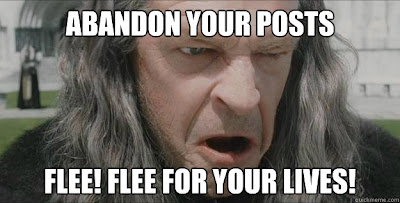
Sorry, couldn’t resist. I actually don’t think we should flee the battlements just yet, for reasons I’ll get into lower down, but this is bad news for Select authors. Phoenix Sullivan has alluded to this, and will surely have more to say herself, so keep watching. Anyway, cause for panic: the new list looks an awful lot like List B. As a refresher, here are the main mechanics (that I am aware of) for how List B works:
- Ranks are determined by the last 30 days of sales, with no extra weight given to the most recent sales
- Free book downloads are discounted heavily–maybe as little as 10% the value of paid sales
- Borrows don’t count as sales
I’m not sure about whether borrows count or not on this new list. Won’t have the data on that front for a while. I am positive free books are counted, and that they’re counted at a discounted rate–feels like 10-15% of a sale. (In other words, for every 10 freebies given away, you’re credited with 1 sale for the purposes of pop list rank.) You can see this for yourself by trolling the popularity lists. You’ll see a few titles that are permanently free scattered across the first few pages. If freebies didn’t count, you wouldn’t be seeing them on the lists at all, and if they did count, you’d see a lot more permafree titles and Select titles higher up on the lists.
Also, if a book has fewer than 30 days of history behind it, as in it’s a new release, that doesn’t seem to be counted against it. Seems like the pop lists will just count however many days it does have on its record.
What does this mean, then? Well, for starters, it’s probably the end of the 3-day bump. This was the term coined on Kindleboards for sales on Select titles that had recently been free. In the past, List A would update roughly 40 hours after your book reverted to free. It counted freebies to sales at a 1:1 ratio (or very close to it) and weighted a book’s last few days of sales very heavily. So if you went free and gave away 5000 books, in the afternoon two days after your promo ended, your book would be credited with 5000 sales, vaulting it to the top of the “most popular” lists. With your book in front of so many customers, you’d see a lot of sales, spiking late on Day 2 and carrying through Day 5 or so as your rank decayed and your book was pushed down the lists by new titles rolling off free.
I don’t think that’s going to happen anymore. For one thing, List B isn’t weighted toward your last few days. It seems to take an average of your last 30. That levels the playing field for books that have been selling steadily for the last month while largely ignoring sales spikes that don’t prove to be lasting. For another thing, when you come off a giveaway of 5000 books, you’re no longer credited with 5000 sales towards determining your pop list rank. Instead, you’re credited with something more like 500. Possibly 750, or even 1000–I’m not sure just what the conversion rate is–just that it’s definitely a lot worse than 1:1.
If you don’t get credited with sales, you won’t vault up the pop lists. If you don’t vault up the pop lists, you won’t be seen by customers. If you don’t get seen by customers, you won’t sell books.
Does this mean those of us in Select should flee from the incoming flood of orcs? Perhaps. Everyone loves a good stampede. But even if the three-day bump has departed for the swift shores of Valinor, freebies aren’t worthless. Giving away a whole bunch of books still means you’ve got your book in the hands of a whole bunch of readers. I hear word of mouth is a thing. While your book’s free, you’ve got tons of attention, meaning some of that attention will bleed over to your other books–especially if it’s a series. If you don’t have a built-in fanbase eagerly awaiting your next release, it might be a viable strategy to put it in Select, make it free right away, and get it some alsobots to help prop up early sales and build a little bit of what the kids call buzz. Furthermore, if you give away just an amazing amount of books, it may still be enough to pull you some decent visibility. Even if you can’t make page 1 of the pop lists anymore, there would be value in using freebies to push yourself up to page 5.
Also, this is just how things look right now. As should be obvious, Amazon changes how they do things all the time. They are wise. They want to make money. If they still want Select to succeed, at some point they will do something to help it, either by changing the algorithms again or by adding new perks to the program. What we’re seeing now will probably be completely irrelevant in another month or three or six.
It should further be noted that I don’t have the algorithms worked out to a T. I know what I’ve described here is incomplete. With the help of the Avengers, I hope we’ll know more soon, but let me stress this: I don’t know everything. I could be wrong about some parts of this or about all of this. I could be a brain in a jar dreaming that Amazon just screwed me!
But I’m pretty confident about what I’ve laid out here. Confident enough to make it public. For those of us who’ve been leaning on Select to sell books, the next few weeks or months could be lean ones. Plan accordingly.
UPDATE: The same day I posted this, Amazon changed their sales algorithms again. This post will provide a lot of the background to what I talk about in the followup post.
BACKGROUND
Around March 19, Amazon changed the way they sell books. In a Kindleboards thread devoted to the subject, authors tracking the performance of books during and after a free promotion began reporting strange results. Prior to then, books that gave away several thousand copies during a promo would shoot to the top of the popularity lists some 36-48 hours later. It was like clockwork. Clockwork that paid you several hundred dollars.
Because the popularity lists are a big deal. These are the default book listings you’ll see when you’re browsing around by genre. Here’s the Fantasy list, for instance, with GRRM clogging up the top 10 like the greedy goose he is. If you could ride a free promotion to the top of those lists, your book would be extremely visible to shoppers. Depending on genre and your book’s presentation, topping the pop lists could snag you dozens or hundreds of sales before other books overtook you. Sometimes that visibility was enough to launch a book into the stratosphere, where the stratosphere is also made of money. It was kind of a big deal.
Then, things changed. Except they didn’t change. Not for everyone. Authors began reporting lower sales than expected as well as strange-looking lists. Chaos reigned! Dogs and cats living together, watching couch-bound authors tear out their hair. After a couple weeks, we thought we had it figured out: there was no longer a single popularity list. There were two, and books no longer seemed to be vaulting to the top no matter how many free copies they gave away.
Well, we were wrong. There weren’t two lists. There were three.
Because I am extremely imaginative, I’m going to refer to them from here on out as List A, List B, and List C. I’ll get into the methodology in a bit, but for now, I worked this out through carefully observing my books, reading other Kindleboard authors’ results obsessively, and lobbing theories around with other authors. I would never have figured this out on my own. I know, never say never. Trust me, eventually I would have gotten frustrated and left to play Mario Kart instead. One other author in particular did tremendous heavy lifting. Like the Eye of Sauron, he (or she?!) is far-seeing and awesomely powerful. And much like Sauron, you can’t invoke his or her name without facing terrible wrath. Some of the Eye’s secrets must remain just that.
But the outcome of that info can be revealed. So without further ado, here’s how the three lists work.
THE CHANGES
List A is the same version of the pop lists that existed prior to March 19. It is Select- and freebie-friendly. Here’s roughly how it works:
- Ranks are heavily weighted to the last few days
- Free book downloads are weighted equally with paid sales
- Borrows count as sales
List B appears to be a throwback pop list, one that was running throughout most of last year. Here’s how book ranks are calculated on it:
- Ranks are determined by the last 30 days of sales, with no extra weight given to the most recent sales
- Free book downloads are discounted heavily–maybe as little as 10% the value of paid sales
- Borrows don’t count as sales
List C is a lot like List B, with a couple major differences:
- Free book downloads aren’t counted at all
- Recent sales are weighted somewhat more heavily than List B(?)
- Borrows don’t count as sales
What does that mean in practice? A lot. A lot a lot a lot. Here’s where my book The White Tree ranks on all three lists at this moment in time. Each shot will look a bit different because they’re taken from different browsers–that’s one way to see different lists. The list in question is Fiction > Fantasy > Series, a fairly quiet little fantasy subcategory.
List A:
List B:
List C:
Pictured: Oh shiiiiii–
METHODOLOGY
Most of this was achieved through comparing tons and tons of different books on different browsers, just like the screenshots above. Here’s some stats for the book in question that helped me figure out what was happening here. On March 28-29, The White Tree was downloaded 4700 times (free). On April 17, it was downloaded an additional 1300 times. In April, its paid numbers came in at 210 sales and 46 borrows.
Since March 19, my main browser’s been displaying List B. My big clue to List B came on April 28, when I noticed my book had, over the span of a day or two, dropped from #67 in Epic Fantasy to #165. Rank didn’t slide–it instantly dropped off a cliff. Why? Because it had been 30 days since all those free downloads had come in. I’d noticed the same thing around March 23–I’d done a huge giveaway February 22-23, and once 30 days elapsed, it suddenly plummeted from around #45 to around #255. I didn’t know what it meant then, in fact I don’t think I even knew there were two lists at that point (let alone three), but when it happened again, I had a pattern.
I also had several weeks of observations piled up by then to help me understand new data. For weeks, List B had been showing me very static lists. The books at the stop stayed at the top. There was very little churn. There were very few Select books, i.e. books that were likely to have recently been free, especially within the top ~60 results (first five pages). Most books at the top were traditionally published. List C was even more trad-dominated; generally speaking, an indie title on List B would be ranked 15-25% worse on List C if that title hadn’t been free, and would rank much, much worse if their List B rank was dependent on free downloads (like, hundreds of places).
When I compared the top 240 titles in Epic Fantasy between List B and List C, here’s what I found: on List B, 188 titles weren’t in Select, and 52 were. On List C, 217 titles weren’t in Select, and just 23 were. With no benefit from freebies, and with fewer paperback sales to pad the numbers, most indies get killed in List C.
When it came to figuring out that borrows weren’t counted in List B and C, The Eye of Sauron was particularly helpful. We compared Select books with lots of borrows to non-Select books whose sales were roughly equivalent to the Select books’ total sales+borrows. On List B and C, the non-Select book came out ahead by a good chunk. We compared Select books with lots of borrows relative to sales with Select books with few borrows : sales. (None of these books had recently been free, which acted as a “control” between List A and B.) The ones with a higher ratio of sales : borrows almost always came out better on List B than on List A.
While I wouldn’t lay my life on the line for every one of these observations, I am very confident in the overall conclusions reached. There are three different lists. You can see them for yourself–just compare lists on different browsers, computers, and Kindles. If you’ve gone free recently, you’ll note your popularity rank on List A is much better than B or C.
How do you tell which list you’re looking at? Well, that could take a day or three to figure out, but in short, if you see a bunch of Select titles on the first pages of the pop lists, you’ve probably got List A. If it’s almost all traditionally published books, it’s List B or C. From there, compare your lists on another browser/device; if you’re seeing List C, trad books will generally be even more dominant.
WHAT THIS MEANS
What does all this mean? Hey, maybe you haven’t noticed, but this post is already epically long. The internet is only so big, you know. I’ll save that for a future post. For now, here’s what’s key: there are three different lists. Your book is listed on all three, but any given shopper is only seeing one version of the lists. (In other words, different people see different lists.) If you’re an indie in Select, one of these lists is good. The other two? Well, let’s just hope they’re not here for too much longer.
I’m presently sitting at just past 125,000 words on the sequel to The White Tree. My outline’s changed here and there in the actual writing of it, but The Great Rift has more or less stuck to my projected word count. That means I’m about 2/3 of the way through the first draft. If I can maintain this pace–which has been fast, but not breakneck–I think I might be done with it by the start of June.
From there, it’s dicey. I think I can revise it in a couple months, but progress on revisions is far less predictable than declaring “Today I shall write 3000 words” and then writing those 3000 words no matter how much crap they may be. Still, if you walked in with a gun and demanded me to put a timetable on it, I would say, “Hey, that’s not very civilized,” and then I would say, “Early August? I hope?” And then you would put the gun away and replace it with a cake that we would both enjoy.
Thanks for the cake. Back to writing.
I will improve this writeup tomorrow. But it’s been a long day, and I need to collapse. In brief, then, a dozen of us indie fantasy writers are doing a one-day Kindle giveaway of some of our books. This runs the classic fantasy gamut–epic, historical, urban. Below are the authors involved, as well as a link to the Amazon pages where their books may be downloaded. Goodnight!
EDIT: Here’s a much nicer link, including snazzy covers, to all the free books.
Also, the list:
Dave King: Betrovia
Edward W. Robinson: The White Tree
Cate Dean: Last Chance Jack
Colin Taber: Fall of Ossard
Matthew Musser: Jadeflies
S. M. Reine: Death’s Hand
Brendan Carroll: The Red Cross of Gold
E. Stoops: Corner of a Round Planet
MeiLin Miranda: Lovers and Beloved
Tristan J. Tarwater: Little Girl Lost
J. R. Tomlin: Blood Duty
Christopher Bunn: Ice and Fire
Kate Danley: Maggie for Hire
Enjoy!
First, some numbers:
12
425
668
Now, some context. That first number is the number of books I sold on Amazon this January. The second number is the number of books I sold on Amazon this February. The third number is my Amazon sales this March. Those represent paid sales–not free giveaways–about 95% of which came from two novels priced at $2.99. To put it another way, in January, I made enough to buy a cheeseburger meal at In-N-Out. In February, I made enough to cover groceries and rent. In March, I made enough to cover rent, groceries, utilities, and expenses on my car.
What changed? I mean, besides my pathetic living conditions?* (Rhetorical trick! I won’t see these checks for months, so nothing’s changed yet. The holes in my kitchen walls are still as big as the ones in my teeth.)
In February, three things changed. First, I released my third novel, Breakers. Second, I finally got a professional cover for The White Tree (and revamped its blurb, too). Third, I wound up enrolling each novel in Amazon’s Select program, a deal where you make your ebook exclusive to Amazon for 90 days (i.e. you can’t sell electronic copies anywhere else). In exchange, your books can be borrowed by Prime members (which you’re paid for), and you can make your book free for up to 5 days during that 90-day period.
The Select program is controversial. One of the major complaints is a philosophical/ethical one: authors don’t want to limit their readers to purchases through Amazon. Some see it as a predatory practice, where Amazon is attempting to further dominate ebook sales by dominating ebook content, too. Those complaints are fair enough. Definitely worth thinking about.
Other authors criticize Select for being a short-term strategy that neglects or harms your long-term sales plans. Earlier this week, Dean Wesley Smith made that very charge in an interesting post about all the ways to build your publishing/indie author business. In the post itself, Smith doesn’t address the specifics of why giving your book away/participating in Select is a narrow, short-term strategy, but elsewhere, I’ve seen it boil down to two major criticisms: a) a giveaway may result in a short-term burst of sales next week, but that won’t help you sell any copies next month or next year, and b) making your work exclusive to Amazon denies you sales and growth on every other ebook market on the planet.
I can’t argue with b). It is literally and undeniably true that if you make your books available exclusively on Amazon, you will not be able to sell them through Barnes & Noble, the Apple store, Sony, Kobo, etc. That’s a perfectly valid point.
But what about a)? Are free giveaways nothing more than a short-term boost to sales that will fade away within days, leaving you with a couple hundred extra bucks, maybe, but nothing in the way of additional readers, fans, and ongoing sales presence?
Phoenix Sullivan looks at that question here. It’s a post well worth reading. In it, she questions the definition of “long-term” in “long-term sales.” Instead, she looks at specific goals. Say you want to sell 50,000 copies of a book, she says. In her words, “If I can make inroads into that number faster by using ‘free’ [giveaways], how is that not a good thing for business?”
It’s not a rhetorical question. It’s a very pointed one. She’s got other questions, too, as well as some nifty graphs indicating free book giveaways may have actually helped her achieve and sustain steady sales over the course of months.
To return to my numbers–12, 425, 668–it would be stupid for me to claim these are all the result of signing up with Select and flinging my books at anyone who cares to click a download. Breakers was selling a few copies before I ever made it free. The White Tree saw an uptick as soon as I upgraded its appearance. My February numbers would have been larger than 12 if I never made any of my books free.
But I did make them free. Weeks after I’ve last done so, they continue to sell more in a day than they had been in a week. If you give away thousands of books, some fraction of those will be read by real people. Some fraction of those real people will turn into real fans. Even with my modest numbers, I’m seeing this already. I can hardly give away The Roar of the Spheres–seriously–but it sold more copies in March than it did in the 8 or 9 months prior to that. Combined. One of its top results for “Customers Who Bought This Item Also Bought” is Breakers. Making one book free caused people to buy one of my other books.
Meanwhile, the money I’m about to start seeing in my bank account is going to allow me to cut back on the freelance work I do. The less time I spend freelancing, the more time I spend writing more novels. (Like the sequel to The White Tree, which I think I have a title for: The Great Rift.)
So I have more readers. I have more fans. Long after I made a book free, more people are buying it than they were before. I have more resources to devote to writing new projects. Oh yeah–and I finally have some proof and confidence this might be a viable career for me.
Select’s still a new program, and it’s not without its faults. I don’t imagine I can continue to give away a few thousand books in exchange for a few hundred sales whenever I please forever and ever. Even if it continues to work like gangbusters for me, I think I will eventually want to start making some or all of my books available in other markets. Diversifying your revenue streams just makes too much sense to rule out for eternity.
But I’m not sure what makes Select or free giveaways a short-term, illusory strategy. Right now, it’s the driving force behind this phase of my long-term plans. A force that is beginning to build my career in a very real way. If Amazon cancels the program tomorrow, that won’t cancel the money I’ve made–or the readers who came with it.
I’m nearing the halfway point of the first draft of the unnamed sequel to The White Tree. It’s a big book. A lot of travel. A lot of new characters. A lot to keep in mind, in other words. Oh, and it might be the better part of 700 pages long. I’m thinking I could use a couple-three beta readers to help me out.
What’s a beta reader? A beta reader’s somebody who reads an early draft of a book with an eye for making it better. This can cover everything from proofreading (“You misspelled ‘rein’ again, dummy”) to problems with characters and plot (“How did they get from the Cauldron of Scalded Souls to Naked Fairy Lake in two days? In chapter 42 you said they were 1000 miles apart”). It’s a pretty broad role, really. Your feedback would pretty much be whatever you feel comfortabe giving. And what do you get in return?
…Nothing! Absolutely nothing! Ah ha ha ha!
Well, not quite nothing. It would be a volunteer position. In most ways, the compensation will be pretty minimal: a free copy of a book you were (presumably) going to buy anyway. Getting to read it weeks or months in advance of when the final version will be released to the public. Helping me increase the book’s overall awesomeness. And a thank you on the acknowledgements page.
It’s probably going to be about three months before I reach this stage, so don’t expect to see any hot new copy until then. But I figure I may as well start casting the net now. So if you read The White Tree, you liked it, and you want to help the sequel be even better, please let me know–just leave a comment with your email here, or drop me a line at edwrobertson AT gmail
From there, I’ll let you know when completed draft day draws near. Thanks, everyone.
Since last month, I’ve been trying out Amazon’s KDP Select program with my novels. Select is, to boil it down, a deal where you make your book exclusive to Amazon for 90 days in exchange for another sales route (borrows) and the ability to make your book free for 5 days. Being allowed to give your book away for nothing might not sound like much of a positive, but it can be kind of a big deal.
By and large, Select has been a very positive experience for me, one I should really blather about here. For now, check out Jim Kukral’s piece on Huffington Post about the pros and cons of the program. In it, he quotes several authors–including one stunningly handsome one–on their experiences with and feelings about Select. It’s a good snapshot of the ambivalent mood and level of success the indie community has for the program.
Oh, and since Jim started gathering his info for the piece, I’ve had another great Select run. Two days ago, I made Breakers free for one day. It was downloaded about 1600 times. Since going back to paid status, I’ve sold a bit over 300 copies.
So yeah, I’m a fan of Select.
